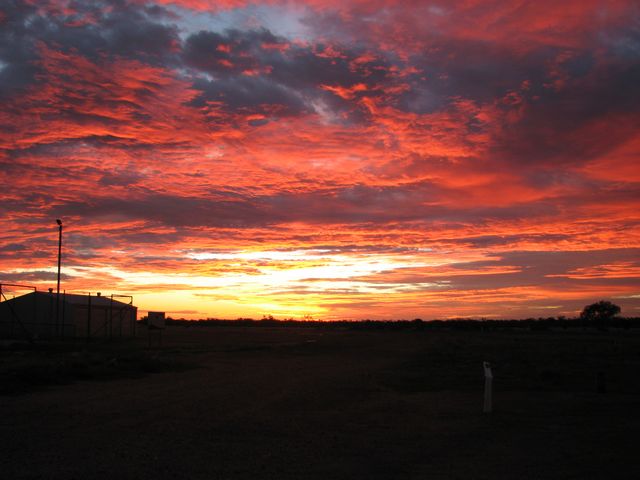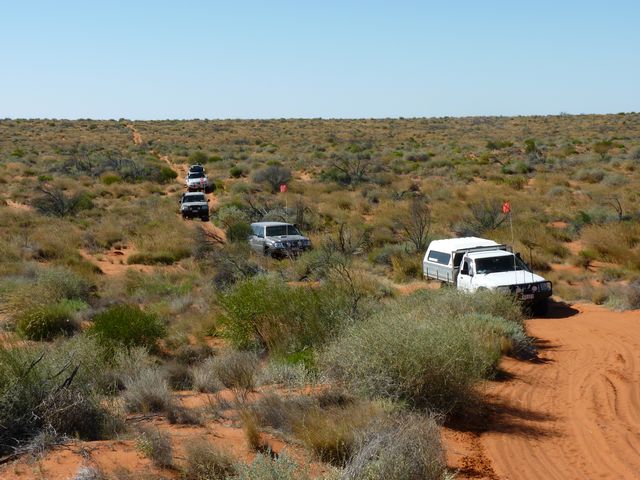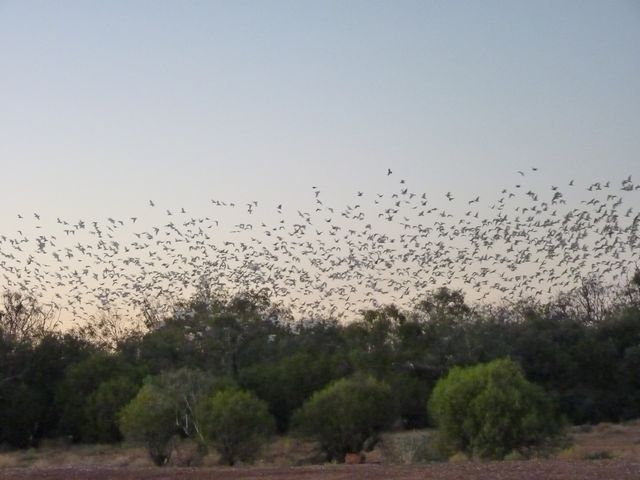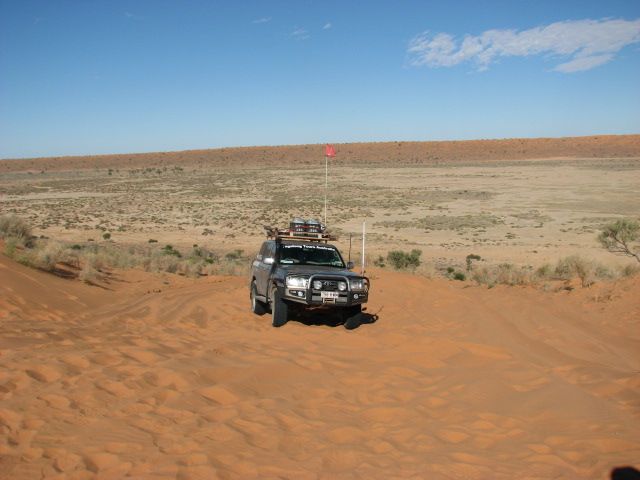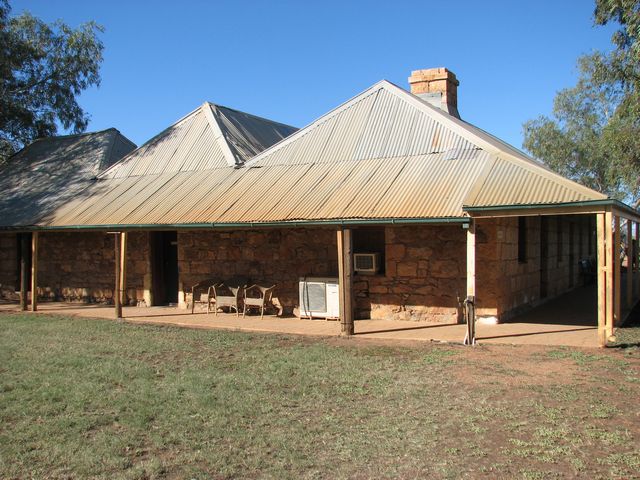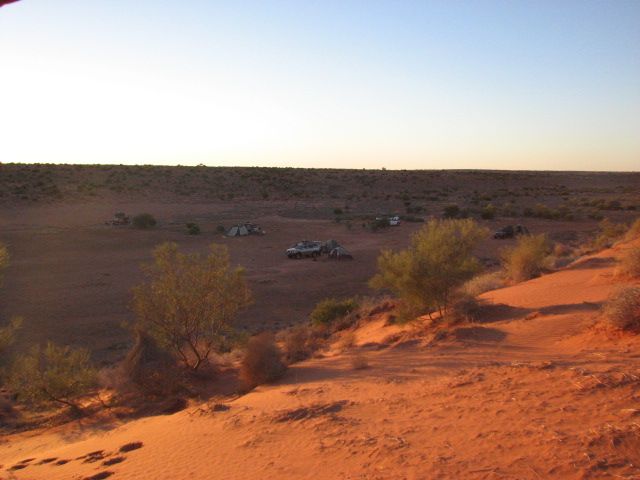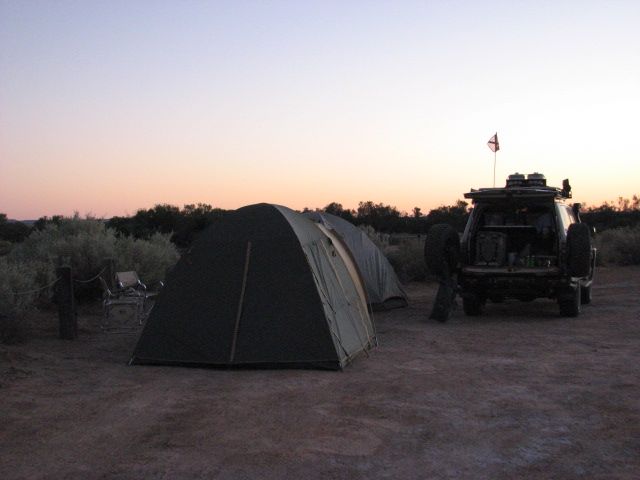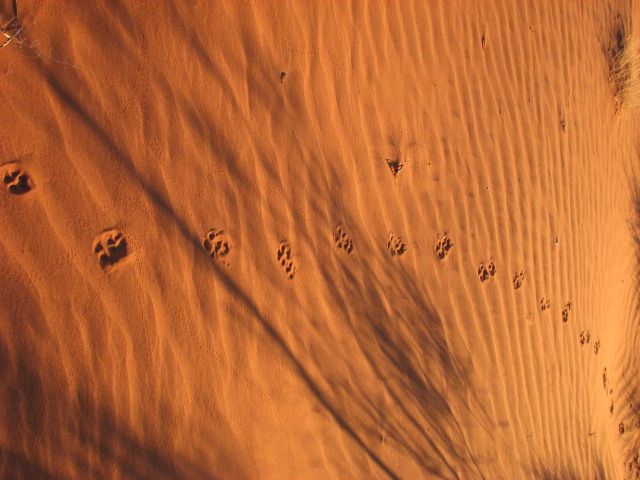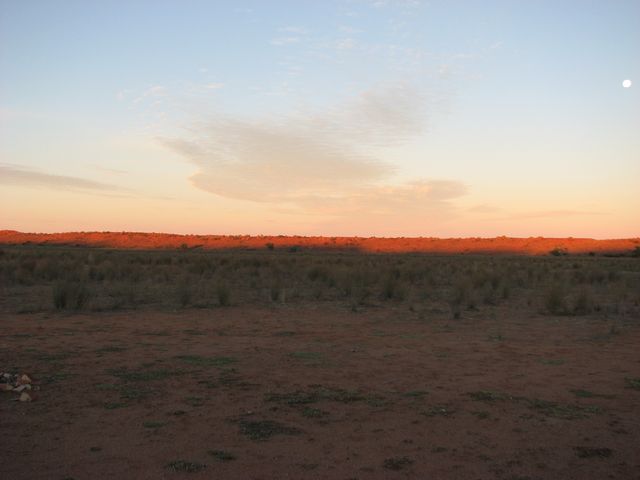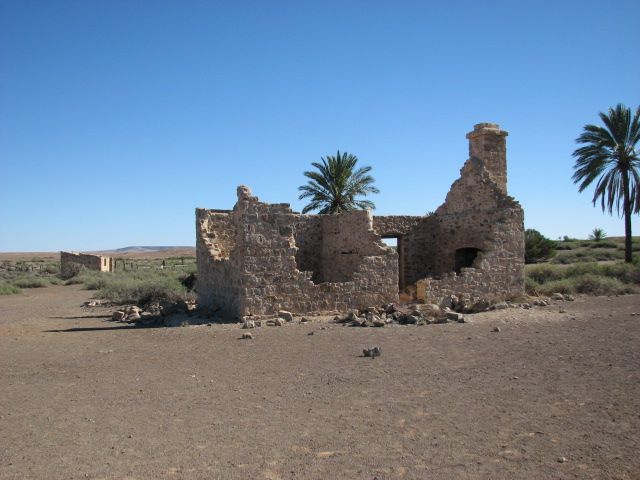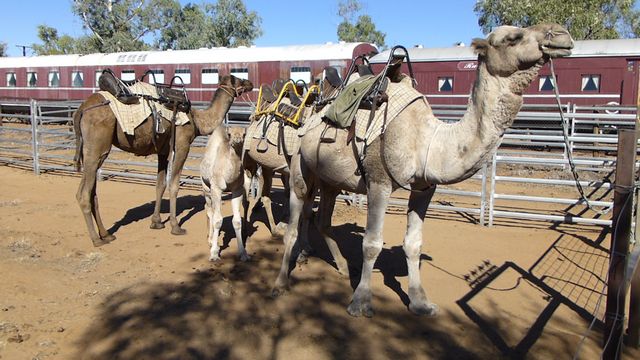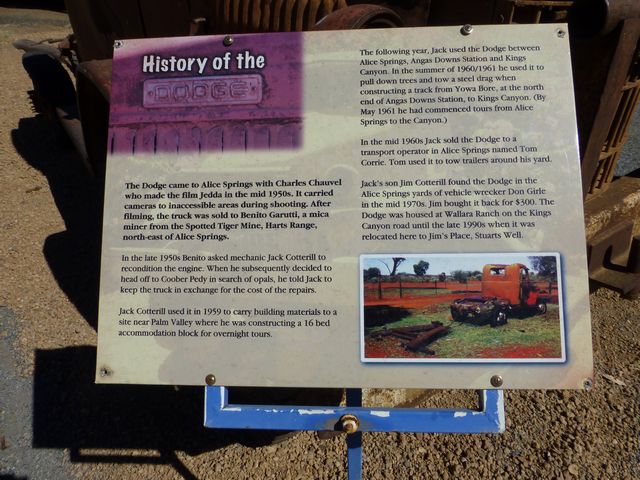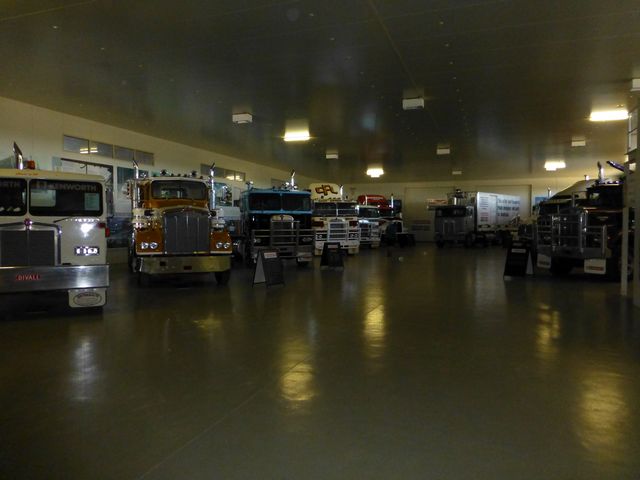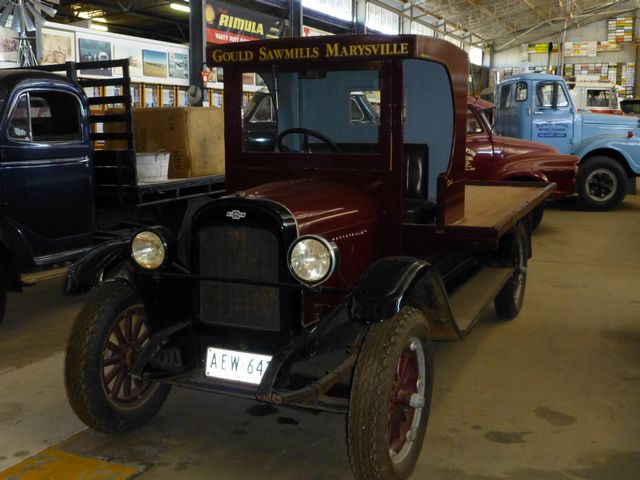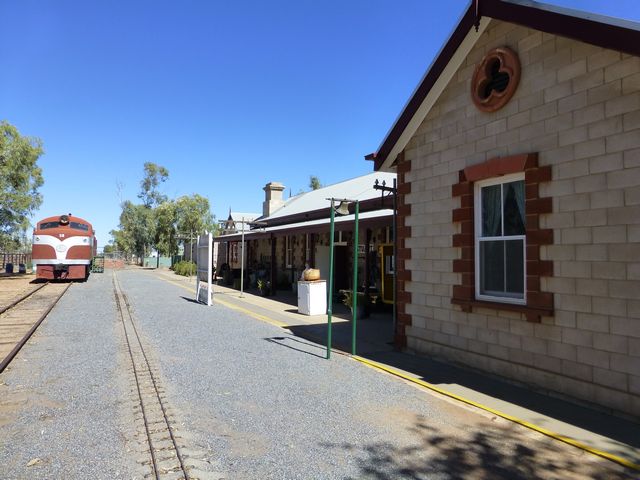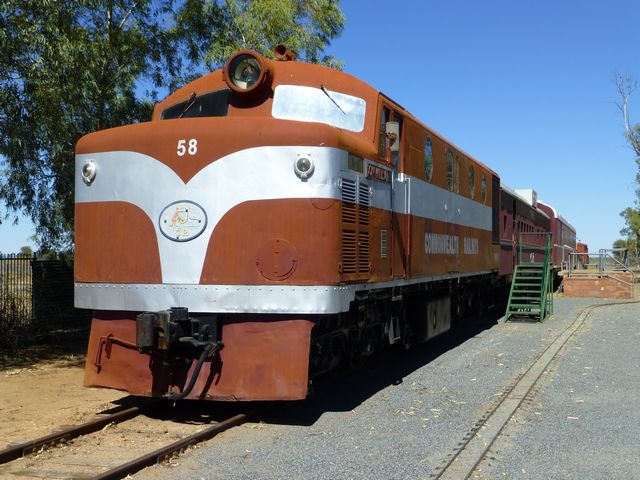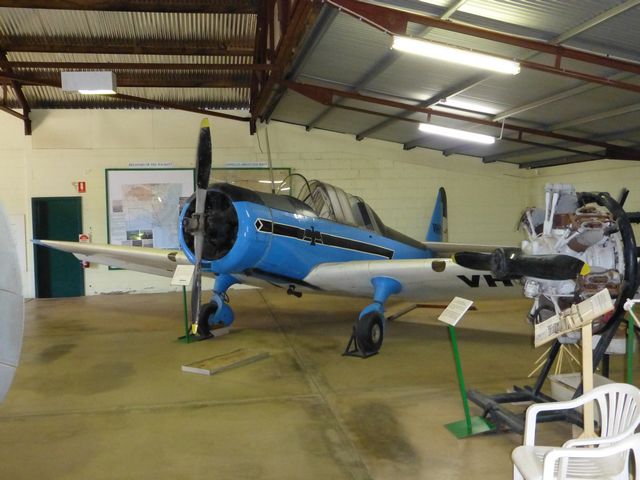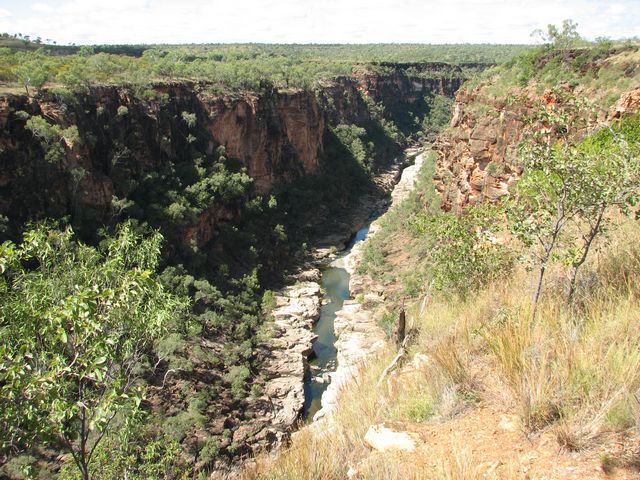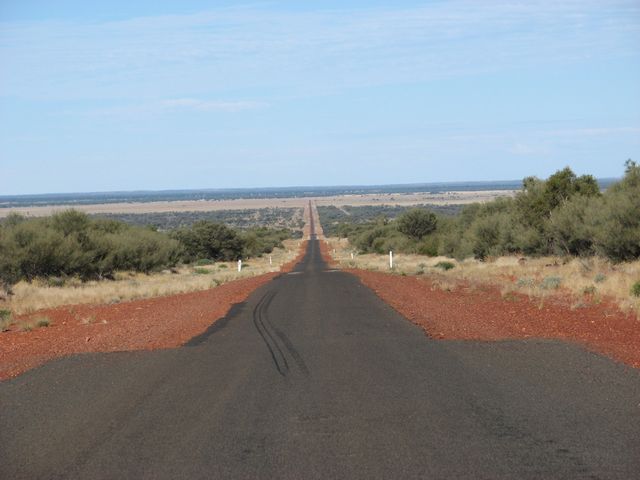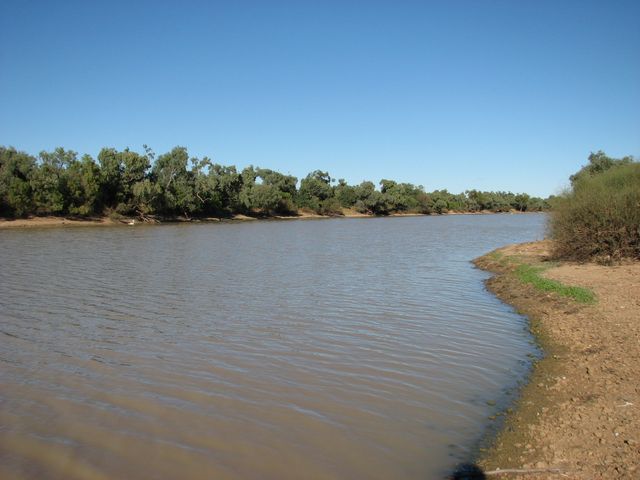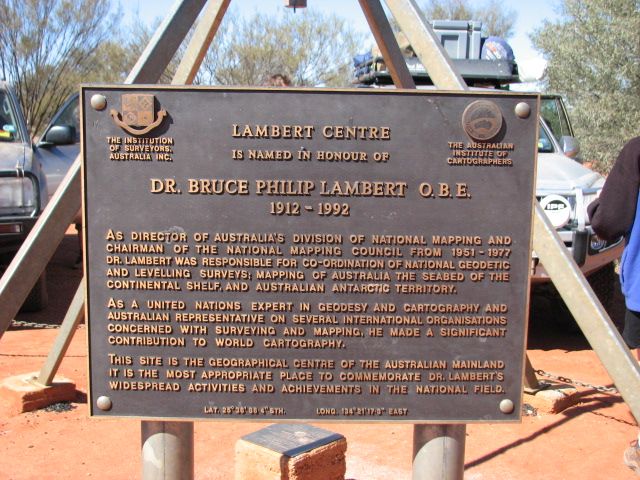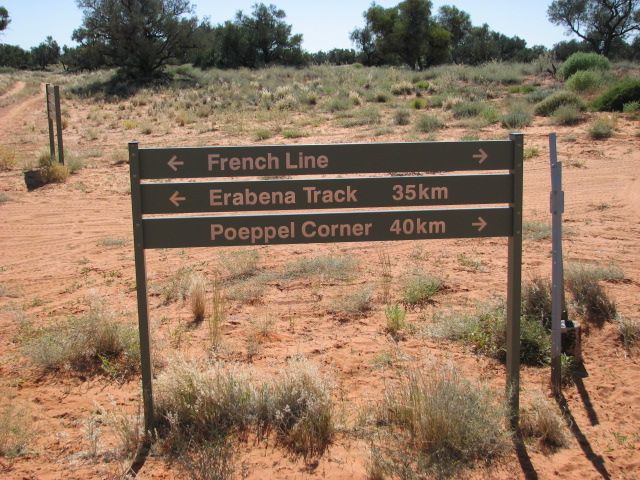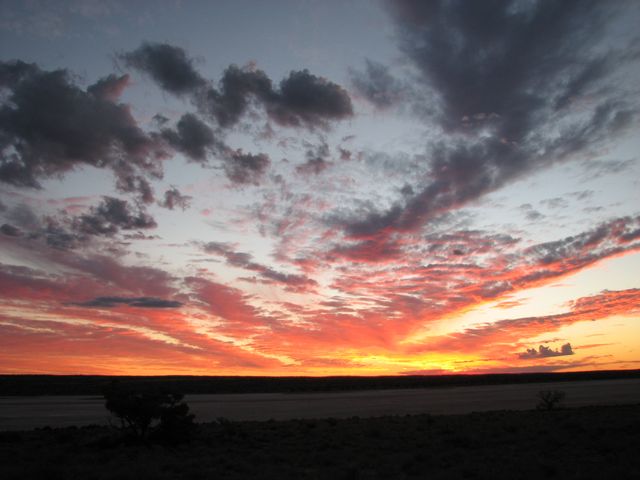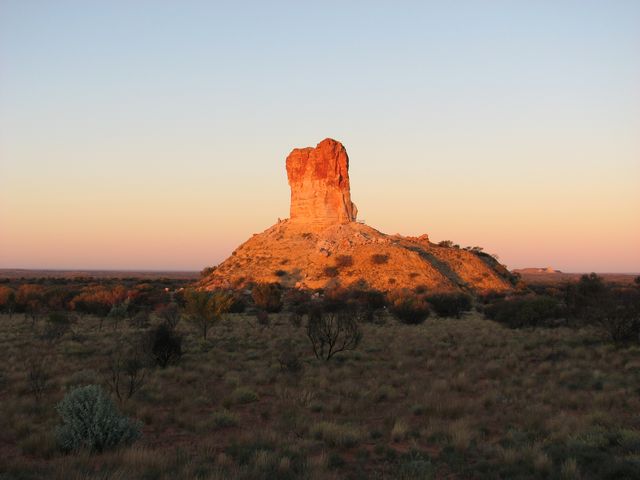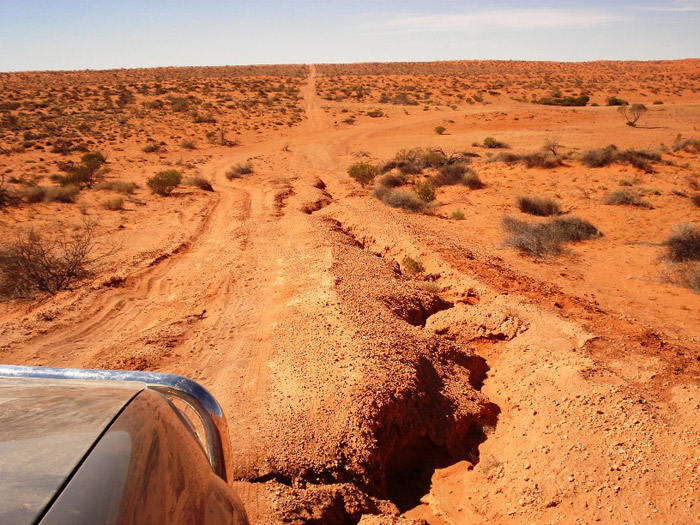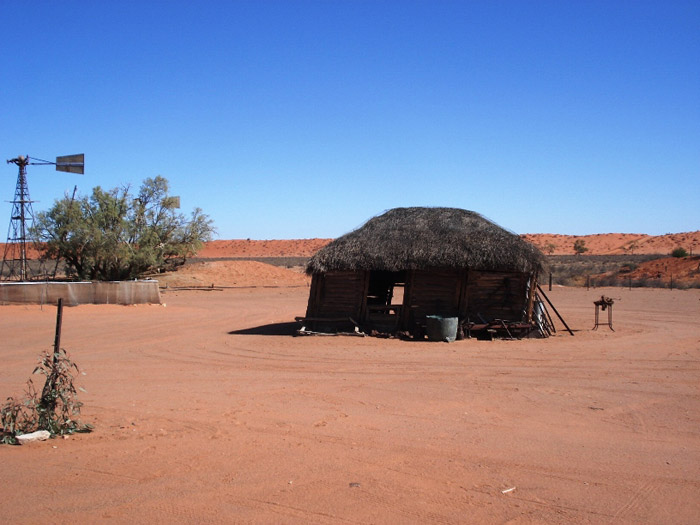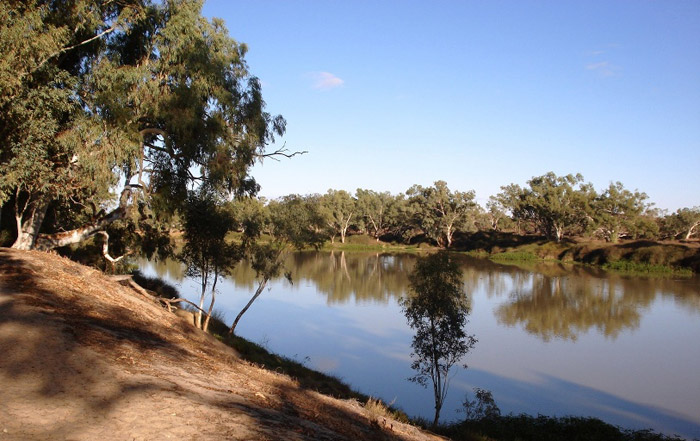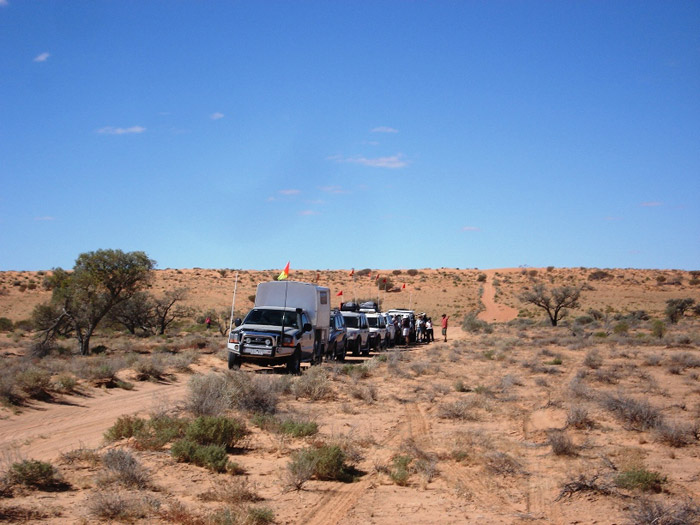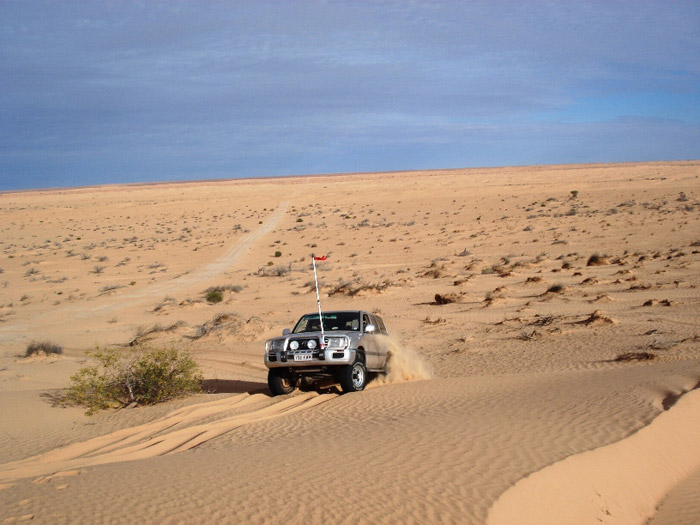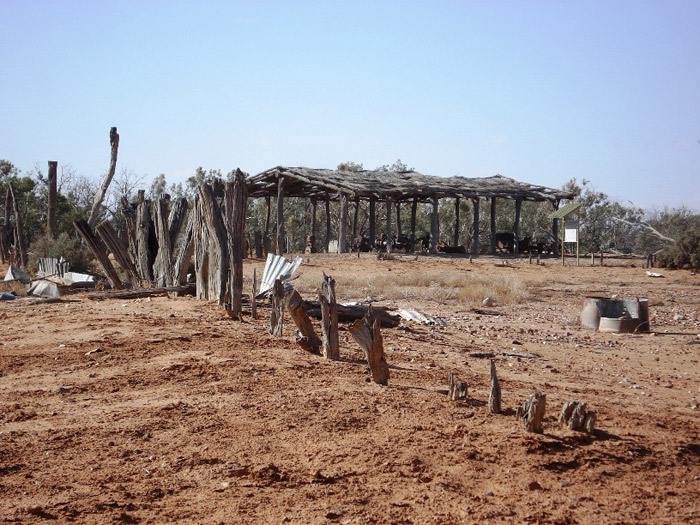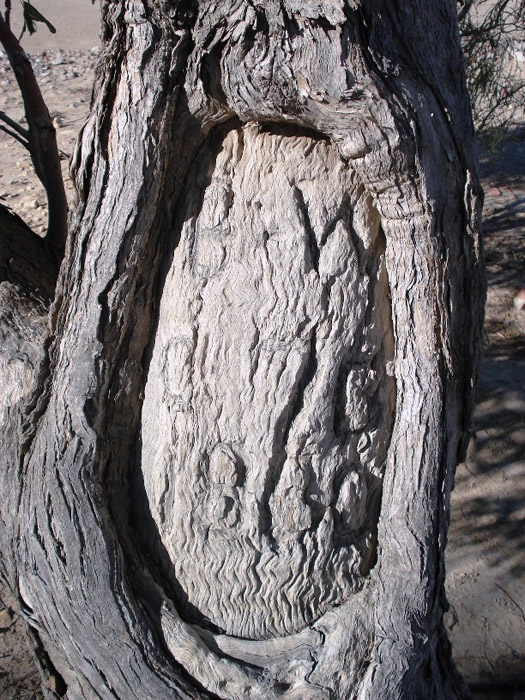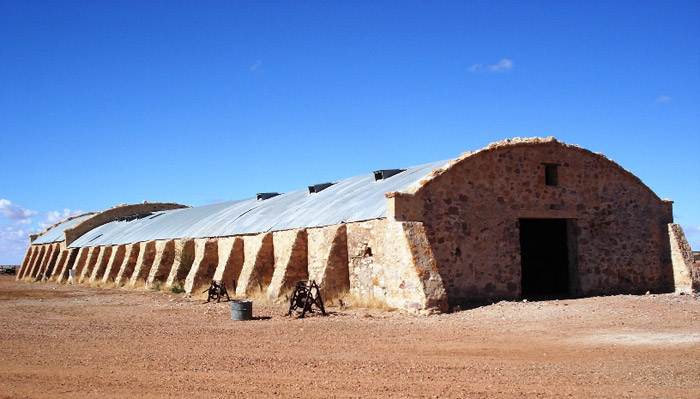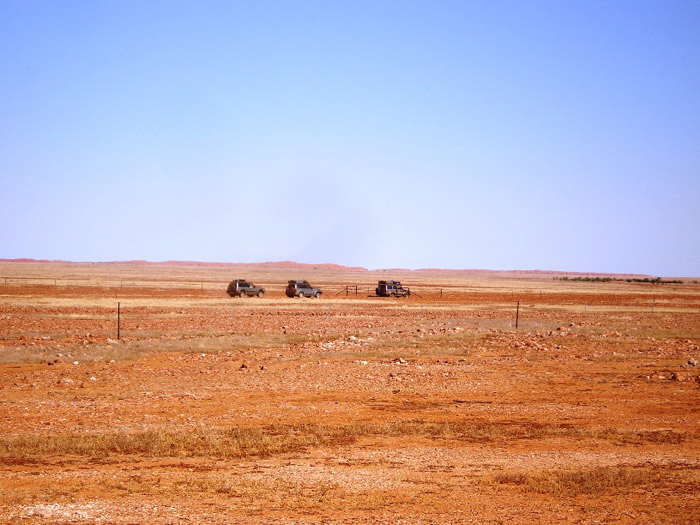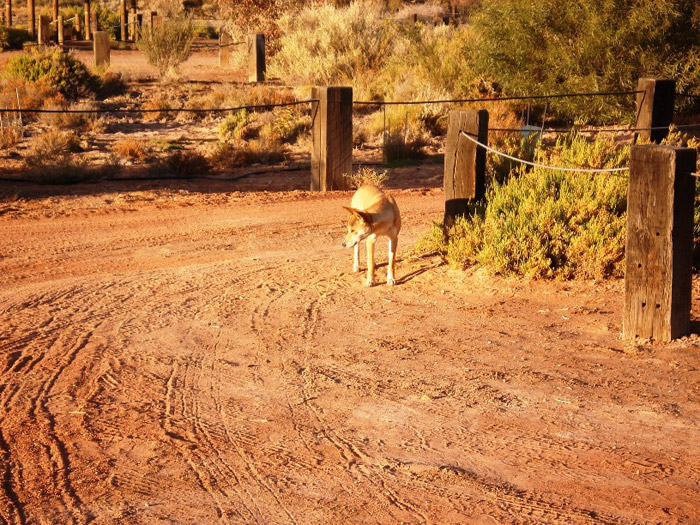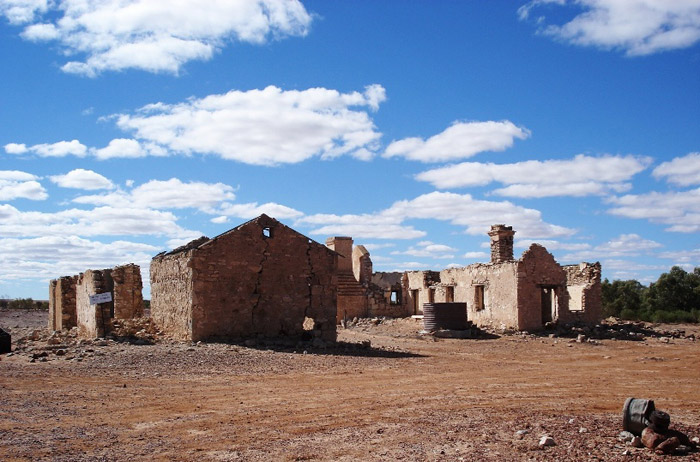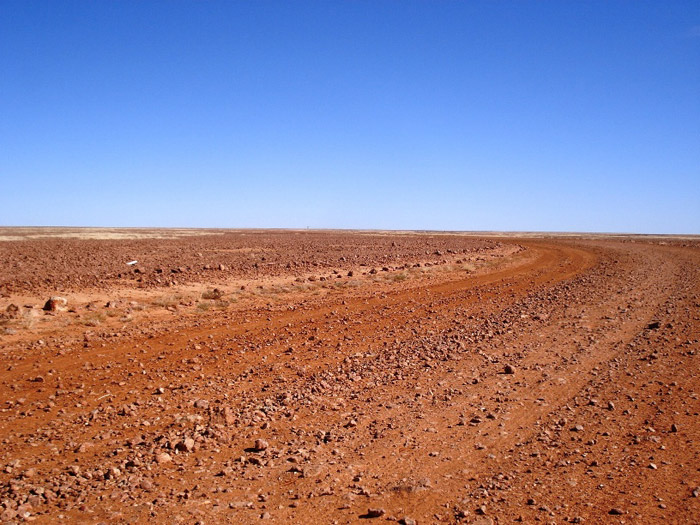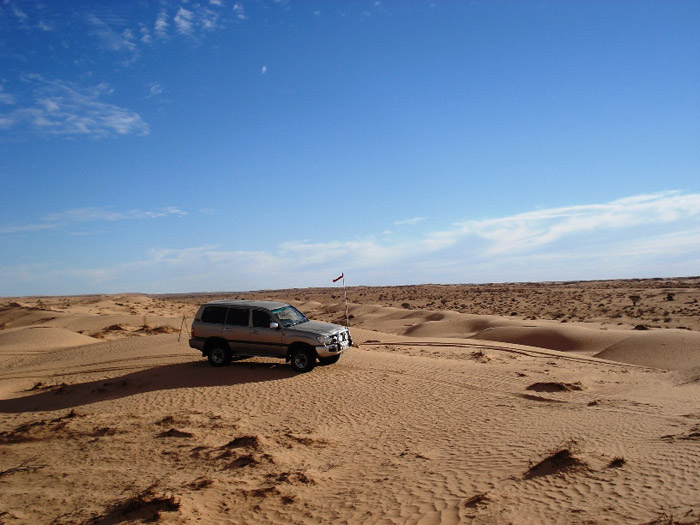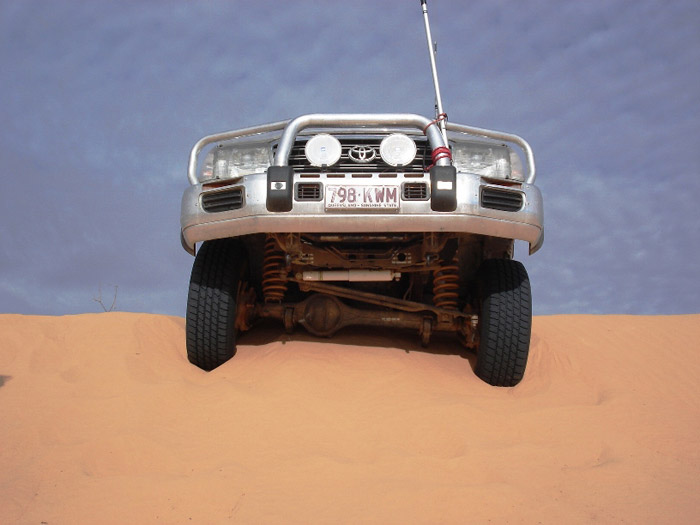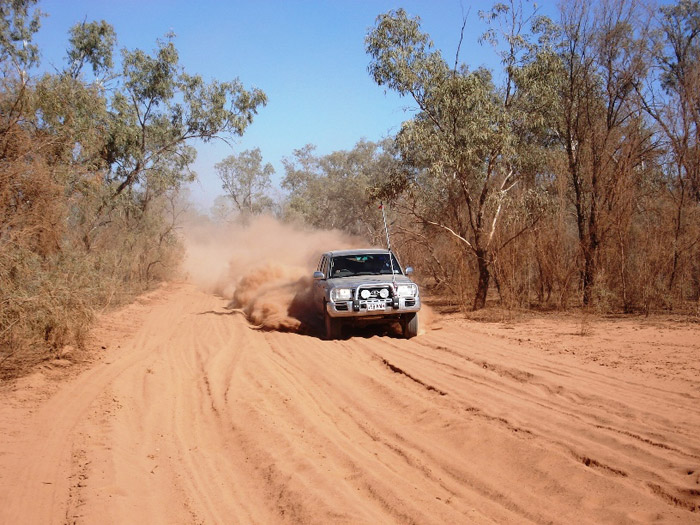The Simpson Desert occupies approximately 176,500 square kilometres of Central Australia.
It is bounded to the west by the Finke River and Mabel Range, to the north by the Adam Range, to the east by the Georgina and Diamantina Rivers, with Lake Eyre to the south. Its average annual rainfall is less than 200mm.
The Simpson Desert is underlain by the Great Artesian Basin, water from which rises to the surface at numerous natural locations, including Dalhousie Springs, and at bores drilled along stock routes, or during gas and oil exploration.
As a result of exploitation by such bores, the flow of water to springs has been steadily decreasing in recent years.
The Simpson Desert is an area which contains the world’s longest parallel sand dunes. These north-south oriented dunes are static, and are held in position by vegetation. They vary in height from 3 metres in the west to around 30 metres on the eastern side.
The most famous dune, Nappanerica, or more popularly known as Big Red (named by Simpson Desert traveller Dennis Bartell), is 40 metres in height.
The explorer Charles Sturt, who visited the region in 1845, was the first European to see the desert, but it was not until 1936 that Ted Colson, on camels, became the first white man to cross it in its entirety.
The name Simpson Desert was coined by Cecil Madigan in 1939, after Alfred Allen Simpson, an Australian philanthropist, geographer, and president of the Royal Geographical Society of S.A.
No maintained roads cross the desert. However, there are tracks that were made during seismic surveys in the search for gas and oil during the 1960s and 1970s. These include the French Line, the Rig Road, and the QAA Line.
Such tracks are still navigable by well-equipped four-wheel-drive vehicles which must carry extra fuel and water.
Towns providing access to the edge of the Simpson Desert include Oodnadatta to the southwest, and Birdsville in the east.
A section of the Commonwealth Railways Trans-Australian line passes through the western side of the Simpson Desert.
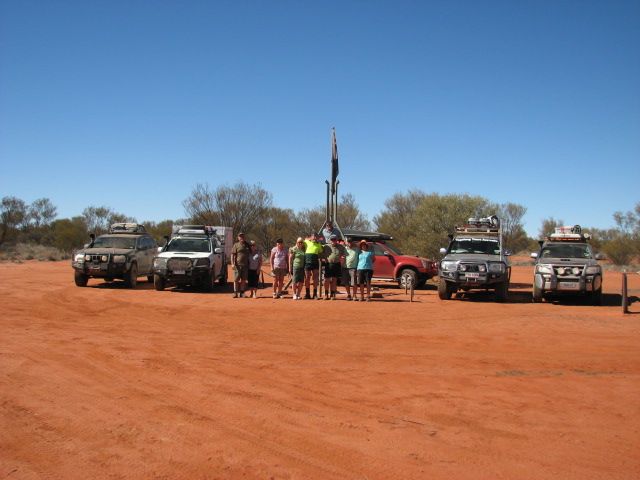
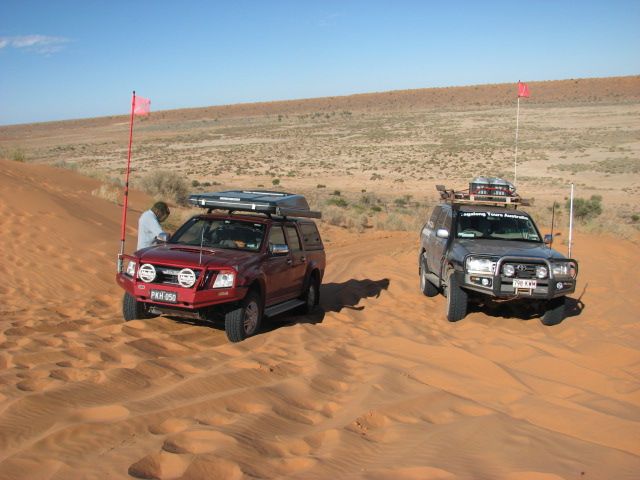
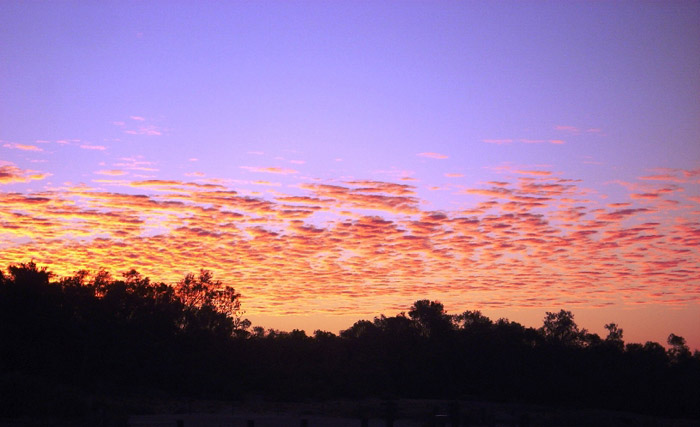
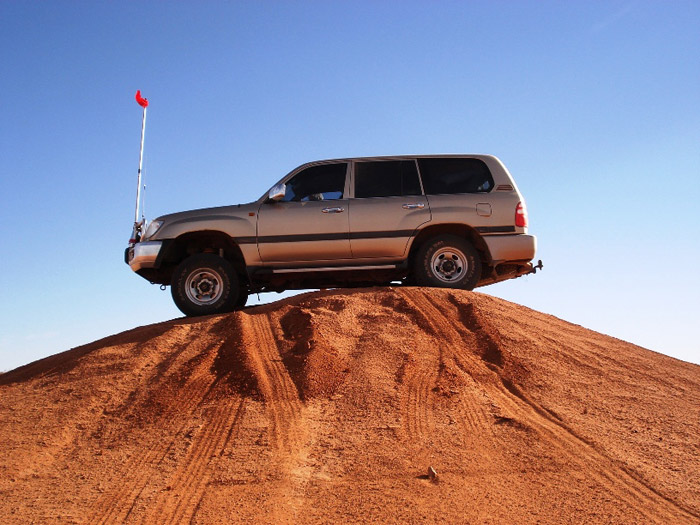
Dates & Pricing
The Simpson Desert occupies over 175,000 square kilometres of Central Australia and contains the world’s longest parallel sand dunes. Join us as we follow in the footsteps of the explorer Charles Sturt, who visited the region in 1845.
Pricing
- Part-Catered Tag-Along – $4,775 per vehicle for 2 people
- Extra person – $950
- Children under 14 – $750
- 10% discount for return customers
Dates
East – West Crossing
May 2nd – May 13th 2025 (3 x spaces left)
West – East Crossing
May 16th – May 27th 2025 (6 x spaces left)
Inclusions
- Welcome Dinner
- Farewell Dinner
- Burke and Wills famous Dig Tree
- Old Andado Historic Homestead
- All National Park permits and all Camping Fees
- Desert Parks Pass
- Fabulous outback sunrises and sunsets
- Toilet facilities and bush showers where water is available
- Camp BBQ plate
- Services of a very experienced tour leader and fully equipped escort vehicle
- Satellite Phone, UHF radio and emergency first aid kit carried by tour leader
- Licensed and accredited tour operator
12 Day Simpson Desert Tour Itinerary
– East to West
Cunnamulla – Alice Springs
PLEASE NOTE :
- All 4WD vehicles on this tour will need to carry extra fuel & water.
- This tour is not suitable for camper trailers.
Day 1
Day 2
Our briefing session in the morning sets the scene for the day’s travel. Then it’s on to Eulo and Thargomindah, the first town in Australia to have its own hydro electric power in the late 1800s. Our destination today is the Wilson River Waterhole, where we will make our camp for the night. It’s not far from the historic sandstone Noccundra Hotel, where we stop in for a drink. A meal can be purchased at the pub if required.
Day 3
The sunrise over the Wilson River Waterhole is often greeted by spectacular squadrons of pelicans as well as hundreds of other birds that have made this remote place their home. Today we continue our journey westward heading for Innamincka. We visit the famous Burke & Wills Dig Tree on Cooper Creek, and the site of Robert O’Hara Burke’s grave and that of William John Wills. We arrive in Innamincka in the afternoon, and set up camp on the Town Common, which is on the banks of Cooper Creek. Tonight, you can dine at the Innamincka Hotel if you don’t feel like cooking.
Day 4
We leave town after breaking camp and head in a northerly direction through the Innamincka Regional Reserve towards Cordillo Downs Station. This property was at one time, the largest sheep station in Australia, with 85,000 sheep covering nearly 8000 square kilometers. We stop and visit the magnificent old stone shearing shed which has been recently restored. It once had stands for 120 shearers and was built in 1885 from materials transported in by camel train. It is now a heritage listed building. Further on, we also explore the ruins of the old Cadelga Homestead before setting up a bush camp here for the night.
Day 5
Today we arrive in the remote western Queensland town of Birdsville and set up our camp at the Birdsville Caravan Park. This town of about 150 residents is renowned for the horse racing carnival and the Big Red Bash concert which are held each year, both attracting thousands of visitors from all around Australia. Our afternoon is a relaxing one, allowing time for some shopping or washing clothes. We round off the day with a visit to Australia’s most famous pub, the Birdsville Hotel. Take the opportunity to buy a beer and stay for dinner if you like.
Day 6
This is a free day in Birdsville where you can treat yourself to a hearty breakfast at the Birdsville Hotel. A visit to the Wirrarri Information Centre is also a must do. There are scenic flights available for interested travellers who want to book them in advance. Also, the Birdsville Cemetery is worth a visit, where you can explore the many old gravesites of our early pioneers. It‘s a testament to the hardships they had to endure in this remote desert country. We refuel our vehicles here as it’s the last fuel stop until Mt Dare.
Day 7
We set off this morning, west along the QAA Line into the Simpson Desert. Soon we are tackling the first and best known of the sand dunes, standing imposingly at around 40 metres high, the awesome Big Red. We continue westward, crossing Eyre Creek and on to Poeppel Corner, where Queensland, South Australia and the Northern Territory all meet. We cross dry lake beds, saltpans and gibber-ironstone flats, keeping an eye out for the local wildlife such as camels and dingoes. It’s out here that we also get to see Australia’s wonderful native wildflowers. Our campsite tonight is another bush camp under a magnificent star filled sky.
Day 8
Our journey today is along a track called the French Line, which got its name in 1963 after a construction party from the Compagnie Generale de Geophysique created it to allow easier access when searching for oil in the desert. There are many suitable sites along the way to stop and camp and we spend another pleasant evening around a crackling camp fire. It’s out here that we get to soak up the fascinating natural beauty of the Simpson Desert.
Day 9
Today we continue our journey west and stop at Purnie Bore, which was originally sunk by the oil research teams. It now sustains large numbers of wildlife in the area. We soon visit the fascinating old ruins of Dalhousie Homestead with its 100 year old date palms gently rustling in the breeze. Our destination tonight is Dalhousie Springs. It’s a delightful oasis in the middle of nowhere, with its warm relaxing waters from the Great Artesian Basin ready to soothe away the aches and pains of weary travellers. We set up our camp here and enjoy the natural surrounds of this unique and beautiful place.
Day 10
After our morning soak we drag ourselves away from Mother Nature’s spa pool and continue our journey. We visit the site of Federal and discover the history of this remote settlement. We stop at the fascinating but tragic old ruins at Bloods Creek with the giant windmill nearby. We soon arrive at South Australia’s most remote hotel, Mount Dare. Here we can have a refreshing drink and buy more fuel if required before crossing into the Northern Territory. Our camp tonight will be under the stars at Old Andado Station. It is probably the only remaining homestead of its kind left in Australia and was the home for over 50 years of that well known outback pioneer, Molly Clark.
Day 11
Today we head back west, and we arrive at the town of Finke, where the Finke Desert Race is held each year in June. We take a short detour to Lambert Centre, which is the geographic centre of Australia, and then head for Maryvale Homestead on the way to the amazing Chambers Pillar. In April 1860, the explorer John MacDouall Stuart was the first white person to see this spectacular pillar of sandstone which towers 50 metres above the surrounding plain. He named it after his South Australian sponsor and friend, James Chambers. This is our last night camping out together in the desert.
Day 12
Today we follow the Old Ghan railway line northwards through the ever changing scenery of red dirt, sand, spinifex, mulga, and desert oaks. It’s here that we see many old relics of The Ghan, left behind at disused railway sidings. Our final destination is the Wintersun Cabin & Caravan Park in Alice Springs. After a welcome hot shower, we all join together for our Farewell Dinner which is provided for us at the Juicy Rump. It’s here that we celebrate our shared adventures from our crossing of the Simpson Desert and the many friendships that we have made along the way.
12 Day Simpson Desert Tour Itinerary
– West to East
Alice Springs – Cunnamulla
PLEASE NOTE :
- All 4WD vehicles on this tour will need to carry extra fuel & water.
- This tour is not suitable for camper trailers.
Day 1
Our adventure begins today as we gather in the Central Australian town of Alice Springs. It’s here that we meet in the afternoon for the first time at the Wintersun Cabin & Caravan Park, where our camping accommodation is already booked. Our Welcome Dinner, which is provided for us at the Juicy Rump Restaurant, gives everyone a great opportunity to get to know each other and talk about the exciting adventures ahead.
Day 2
Today we leave the Alice and follow the Old Ghan railway line south through the ever changing scenery of red dirt, sand, spinifex, mulga, and desert oaks. It’s here that we see many relics of the old Ghan, left behind at disused railway sidings. We head for Maryvale Homestead on the way to the amazing Chambers Pillar. In April 1860, the explorer John MacDouall Stuart was the first white person to see this spectacular pillar of sandstone which towers 50 metres above the surrounding plain. He named it after his South Australian sponsor and friend James Chambers. Our bush camp is within walking distance of Chambers Pillar and a spectacular sunset is always worth a photo.
Day 3
After breakfast we head back to the main track and turn south again towards the town of Finke, where the Finke Desert Race is held each year in June. We take a short detour to Lambert Centre, which is the geographic centre of Australia. Our camp tonight will be under the stars at Old Andado Station. This is probably the only remaining homestead of its kind left in Australia and was the home for over 50 years of that well known outback pioneer, Molly Clark.
Day 4
This morning we leave this historic homestead behind and head to South Australia’s most remote hotel at Mount Dare. Here we can have a refreshing drink, but more importantly we must fill our fuel tanks as this is the last available fuel until we get to Birdsville. We visit the fascinating but tragic old ruins at Bloods Creek near the giant windmill and visit the site of Federal. Then it’s off to the ruins at Dalhousie Homestead with its 100 year old date palms rustling gently in the breeze. Our destination tonight is Dalhousie Springs, a delightful oasis in the middle of nowhere, with its warm relaxing waters from the Great Artesian Basin ready to soothe away the aches and pains of weary travellers. We set up our camp here and enjoy the natural surrounds of this unique and beautiful place.
Day 5
After our morning soak we drag ourselves away from Mother Nature’s spa pool and continue our journey towards the east. Our next stop will be Purnie Bore, which was originally sunk by the oil research teams. It now sustains large numbers of wildlife in the area. We are now getting well into the desert on a track known as the French Line. It got its name in 1963 after a construction party from the Compagnie Generale de Geophysique created it to allow easier access when searching for oil in the desert. There are many suitable sites along the way to stop and camp and we spend another pleasant evening around a crackling camp fire. It’s out here that we get to soak up the fascinating natural beauty of the Simpson Desert.
Day 6
We set off this morning and soon we are crossing more sand dunes, dry lake beds, saltpans and gibber-ironstone flats. Along the way, we keep an eye out for the local wildlife such as camels and dingoes. It’s out here that we also get to see some of Australia’s wonderful native wildflowers. We continue eastward towards Poeppel Corner where Queensland, South Australia and the Northern Territory all meet. Our campsite tonight is another bush camp under the stars.
Day 7
After crossing into Queensland, we continue to travel east along the QAA Line and eventually we cross Eyre Creek. In the afternoon, we get to tackle the last and best known of the sand dunes, standing imposingly at around 40 metres high, the awesome Big Red. We arrive in the remote western Queensland town of Birdsville and set up our camp at the Birdsville Caravan Park. This town of about 150 residents is renowned for the horse racing carnival and the Big Red Bash concert, both of which are held each year and attract thousands of visitors from all around Australia. We round off the day with a visit to Australia’s most famous pub, the Birdsville Hotel. Take the opportunity to buy a beer and stay for dinner if you like.
Day 8
This is a free day in Birdsville where you can treat yourself to a hearty breakfast at the Birdsville Hotel. A visit to the Wirrarri Information Centre is also a must do. There are scenic flights available for interested travellers who want to book them in advance. Also, the Birdsville Cemetery is worth a visit, where you can explore the many old gravesites of our early pioneers. It‘s a testament to the hardships they had to endure in this remote desert country We refuel our vehicles here as it’s the first fuel stop since we left Mt. Dare.
Day 9
All refreshed, we leave town after breaking camp and head towards the east. We are soon travelling south through the Sturt Stony Desert, where we get to explore the ruins of the old Cadelga Homestead. Our next stop is Cordillo Downs Station. This property was at one time, the largest sheep station in Australia, with 85,000 sheep covering nearly 8000 square kilometers. We see the magnificent old stone shearing shed which has recently been restored. It once had stands for 120 shearers and was built in 1885 from materials transported in by camel train. It is now a heritage listed building. Our bush camp tonight is at the remote Mulga Bore.
Day 10
Today we visit the grave site of Robert O’Hara Burke and that of William John Wills. We arrive in the tiny settlement of Innamincka in the afternoon, and set up camp on the Town Common, which is on the banks of Cooper Creek. Tonight, you can dine at the Innamincka Hotel if you don’t feel like cooking.
Day 11
Our journey this morning takes us east and we get to visit the famous Burke & Wills Dig Tree on Cooper Creek. We travel through the oil and gas fields to the large cattle property of Nockatunga, where our destination today is the Wilson River Waterhole. Here we make our camp for the night, not far from the historic sandstone Noccundra Hotel, where we stop in for a drink. A meal can be purchased at the pub if required.
Day 12
After breakfast it’s on to Thargomindah, the first town in Australia to have its own hydro electric power in the late 1800s. We stop at Eulo and we camp tonight in Cunnamulla, which is situated on the banks of the Warrego River, at the Cunnamulla Tourist Park. After a well earned shower, we look forward to our Farewell Dinner, which is provided for us in the evening. It’s an outdoor cook up over an open fire, and it provides a great opportunity for everyone to talk about their adventure and their unforgettable journey across the Simpson Desert.

